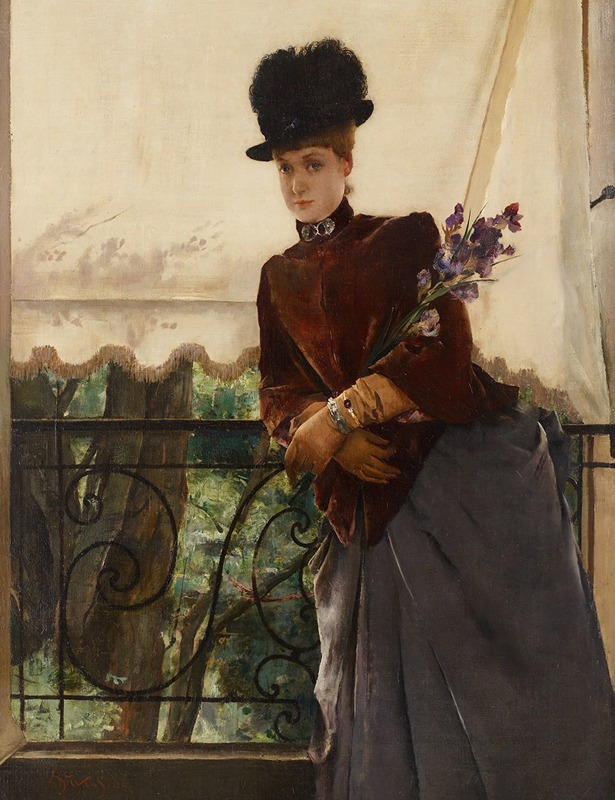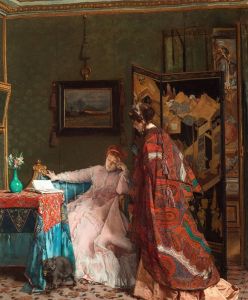
Portrait of Mademoiselle Dubois
A hand-painted replica of Alfred Stevens’s masterpiece Portrait of Mademoiselle Dubois, meticulously crafted by professional artists to capture the true essence of the original. Each piece is created with museum-quality canvas and rare mineral pigments, carefully painted by experienced artists with delicate brushstrokes and rich, layered colors to perfectly recreate the texture of the original artwork. Unlike machine-printed reproductions, this hand-painted version brings the painting to life, infused with the artist’s emotions and skill in every stroke. Whether for personal collection or home decoration, it instantly elevates the artistic atmosphere of any space.
Alfred Stevens, a renowned Belgian painter of the 19th century, is celebrated for his exquisite portraits and genre scenes that often depict women in elegant settings. One of his notable works is the "Portrait of Mademoiselle Dubois," which exemplifies his skill in capturing the grace and refinement of his subjects.
Alfred Stevens was born in Brussels in 1823 and was a prominent figure in the art world during his lifetime. He studied at the Académie Royale des Beaux-Arts in Brussels and later at the École des Beaux-Arts in Paris, where he was influenced by the works of contemporary artists and the burgeoning Realist movement. Stevens became known for his ability to blend realism with a sense of elegance and sophistication, which is evident in his portraits.
The "Portrait of Mademoiselle Dubois" is a testament to Stevens' mastery of portraiture. Although specific details about the sitter, Mademoiselle Dubois, are scarce, the painting itself provides insight into the fashion and social milieu of the time. Stevens had a keen eye for detail, and his portraits often feature meticulously rendered fabrics and textures, highlighting the luxurious attire of his subjects. This attention to detail not only showcases his technical prowess but also offers a glimpse into the cultural and social context of the 19th-century bourgeoisie.
In this portrait, Stevens employs a subtle color palette, which is characteristic of his style. The use of soft, muted tones creates a harmonious composition that draws the viewer's attention to the subject's face and expression. Stevens was adept at capturing the nuances of his sitters' personalities, and in this work, he conveys a sense of poise and introspection. The background is typically understated, ensuring that the focus remains on Mademoiselle Dubois herself.
Stevens' portraits are often celebrated for their psychological depth, and the "Portrait of Mademoiselle Dubois" is no exception. The artist's ability to convey the inner life of his subjects is one of the reasons his work remains highly regarded. His portraits go beyond mere representation, offering a window into the character and emotions of the individuals he painted.
Throughout his career, Alfred Stevens received numerous accolades and was highly sought after by patrons across Europe. His works were exhibited in prestigious salons, and he was awarded several honors, including the Legion of Honor in France. Despite the challenges faced by artists during periods of political and social upheaval, Stevens maintained a successful career and left a lasting impact on the art world.
Today, Stevens' paintings, including the "Portrait of Mademoiselle Dubois," are held in high esteem and can be found in major museums and private collections worldwide. His ability to capture the elegance and complexity of his subjects continues to resonate with audiences, ensuring his place in the canon of 19th-century art.
In summary, the "Portrait of Mademoiselle Dubois" by Alfred Stevens is a fine example of the artist's skill in portraiture, characterized by its attention to detail, subtle color palette, and psychological depth. While specific information about Mademoiselle Dubois remains limited, the painting itself stands as a testament to Stevens' ability to capture the essence of his subjects and the era in which they lived.


















